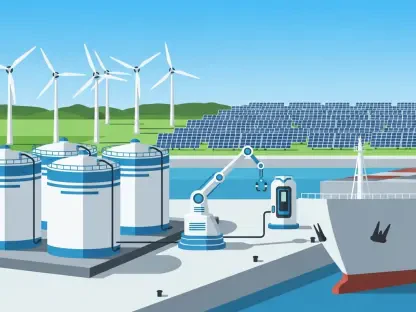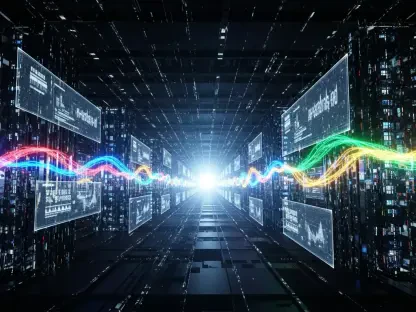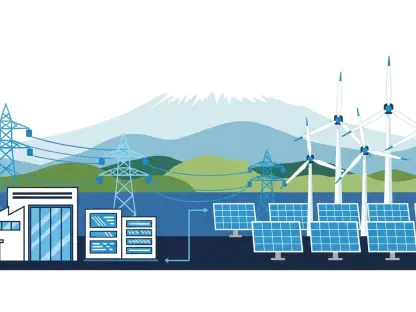U.S. President Donald Trump is pushing for an artificial intelligence (AI) technology revolution amidst energy and innovation uncertainties. This drive, significantly fueled by the emergence of a groundbreaking Chinese AI model from DeepSeek, brings forth numerous complexities involving energy consumption, technological efficiency, investments in AI infrastructure, and geopolitical implications. As Trump endeavors to establish the United States as a global AI leader, the challenges accompanying this ambition become increasingly apparent and daunting.
Trump’s Ambition for AI Leadership
Trump has long been determined to position the United States as the paramount leader in AI technology. This ambition has taken on renewed urgency with the recent launch of DeepSeek’s AI model, DeepSeek-R1. This model, reportedly more efficient than its U.S. counterparts, has triggered substantial market shocks and raised significant concerns about energy consumption and long-term sustainability. The advent of DeepSeek-R1 has notably impacted Nvidia, a leading U.S. AI chipmaker, thus creating a heightened sense of urgency around Trump’s AI initiatives.
A critical concern in this rapidly evolving AI landscape is the energy requirement needed to sustain robust AI development. Data centers, which serve as the backbone of AI technologies, are notoriously energy-intensive, leading to predictions of significantly increased electricity demand in the coming years. Tanya Das, director of AI and energy technology policy at the Bipartisan Policy Center, compares the current situation to the internet boom of the late 1990s and early 2000s. She notes that just as there were initial fears that the internet could potentially overwhelm the energy grid, similar fears are now surfacing about AI, although the overall future remains uncertain.
Energy consumption patterns specific to the AI boom illustrate stark data points, indicating a substantial demand. For instance, ChatGPT, a popular AI model, consumes approximately ten times more energy per query than a typical Google search. Additionally, a 100-word email generated by an AI chatbot uses significant resources, including enough electricity to power 14 LED light bulbs for an hour and half a liter of water. This demand scale-up translates into immense national resource consumption. A theoretical analysis revealed that if one in ten Americans produced one such email per week for a year, the total energy consumption would correspond to the water usage by all Rhode Island households over one and a half days and the electricity consumed by Washington, D.C. households over 20 days.
Energy Consumption and AI Development
Despite these formidable challenges, Trump remains steadfast in his aggressive AI agenda. During his first presidency, he spearheaded a national AI strategy and established the National AI Initiative Office. In his second term, Trump has used emergency declarations to expedite the construction of AI power plants and has prioritized rapid approvals for AI data center power structures. Reinforcing this resolute approach, Trump’s Environmental Protection Agency (EPA) head, Lee Zeldin, declared AI a primary agency focus, emphasizing support for U.S.-based AI development and the clean operation of data centers using American-made energy resources. Zeldin expressed confidence that under Trump’s leadership, the U.S. could become the AI capital of the world.
The alignment of Trump’s goals with substantial investments has spotlighted a new joint venture known as the Stargate Project, involving OpenAI, SoftBank, and Oracle. This venture outlines a plan to invest up to $500 billion in enhancing U.S. AI infrastructure over the next four years, with OpenAI pledging to deploy $100 billion immediately. However, financial feasibility remains ambiguous, with notable figures like tech billionaire Elon Musk expressing skepticism about the firms’ ability to meet these investment commitments.
The emergence of DeepSeek-R1, while propelling Trump’s AI narrative, underscores the fierce technological rivalry between the United States and China. Trump has reiterated the importance of ensuring that the United States remains a dominant force in AI development. Industry experts like Thomas Pyle, president of the American Energy Alliance, highlight the competitive stakes between the United States and China in this high-tech race.
Energy Usage and Utility Challenges
The precision and efficacy of DeepSeek’s model bring into question the expected energy usage for future U.S. AI endeavors. As the energy consumption of data centers continues to grow, estimates suggest a significant national increase, possibly tripling by 2028. A study conducted by the Lawrence Berkeley National Laboratory, with endorsement from the Department of Energy, indicates that annual energy use from data centers could represent between 6.7% and 12% of total U.S. electricity consumption in the next three years. However, experts caution about the variability in these projections, attributing uncertainty to factors like the unpredictable growth in AI usage and the evolving advancements in efficiency.
An equally pressing concern is the capacity of utility companies to meet the projected energy demands of AI expansion. Experts like Jonathan Koomey, president of Koomey Analytics, note the inherent lag in utility infrastructure development compared to the rapid pace preferred by the tech sector. Utility companies typically plan meticulously for long-term infrastructure usage, spanning decades or even centuries, thereby complicating the swift scaling necessary for AI advancements.
This misalignment in scaling timelines represents a significant barrier. Joshua Rhodes, a research scientist at the University of Texas at Austin, explains that AI companies present abrupt and overwhelming energy needs to utility firms, which are unaccustomed to such immediate demands. In this scenario, cooperation from utility firms cannot be presumed, as they operate under significantly different timelines and priorities compared to technology companies.
Environmental Concerns and Energy Sources
U.S. President Donald Trump is advocating for a revolution in artificial intelligence (AI) technology amid ongoing uncertainties in energy and innovation sectors. This ambitious initiative gains momentum due to the introduction of a groundbreaking Chinese AI model developed by DeepSeek. The drive raises several complex issues, such as energy consumption, technological efficiency, and the need for significant investments in AI infrastructure. Additionally, it carries notable geopolitical implications, as the race for AI supremacy on the global stage intensifies. As Trump pushes to position the United States as a world leader in AI, the challenges and obstacles associated with this goal become more apparent and overwhelming. His commitment to advancing AI technology aims to secure national interests, boost economic growth, and reinforce the U.S.’s competitive edge. However, the complexities surrounding energy usage, financial investments, and international dynamics contribute to a multifaceted landscape that needs careful navigation. Balancing innovation with sustainable energy practices and fostering global cooperation will be essential as the U.S. strives to dominate the AI landscape while managing the inherent risks and rewards.









